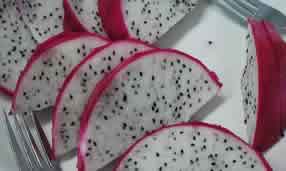The wood apple or
bael has interesting properties. The ripe
fruit acts as a laxative whereas the unripe fruit helps control
diarrhea. The bael is a medium sized deciduous tree reaching up to 8 m
in height.
The fruit is a globose, woody berry with yellowish rind. Its seeds
are numerous, oblong, compressed, embedded in orange brown sweet gummy
pulp. The root, fruit and leaves of this tree are used as medicine.
Ayurvedic recommendations
Fruit: The unripe fruit is bitter in taste, acrid,
sour, and astringent in nature. It is useful in treating diarrhea and
dysentery. The ripe fruit is sweet in taste, aromatic, cooling, and
astringent. It acts as a laxative and has tonic properties. It is a
popular medicine for dyspepsia in India and is widely used to strengthen
the heart and brain.
Root: The root is astringent in nature and is sweet
and bitter in taste. The dry and light root is used for medicinal
purposes. It is useful in conditions such as seminal weakness, diarrhea,
dysentery, dyspepsia, stomatitis, vomiting, fever, swellings, and
gastric irritation. It is also good for the heart and the brain.
Leaves: The leaves have an astringent quality and
are used as laxative and expectorant. The bael leaves are useful in
treatment of eye diseases, deafness, inflammations, diabetes, and
asthma.
Therapeutic sctions
1. The fruit is very helpful in chronic constipation, chronic dysentery, and dyspepsia.
2. The fruit extract is widely used in Ayurveda for the treatment of diabetes.
3. The ripe fruits are dried in sun and powdered. This powder
improves debility of the mucus membrane (used only when there is no
fever).
4. Leaves are applied to the joints as poultice to relieve joint pain.
5. The root bark or stem bark infusion is a well-practiced recipe for fevers and fever associated with diarrhea.
6. The fruit extract is used as a preventive drug for cholera and piles.
7. Stem bark infusion is useful in palpitations and hypotension.
8. Fresh leaf juice mixed with pepper is therapeutically valuable in cases of jaundice and anorexia.
9. The bael bark extract is the best medicine for amoebic dysentery.
Side effects
1. Large quantities may result in digestive disorders and constipation.
2. It may lower blood sugar.
3. Patients with thyroid disorders should avoid bael.
4. Bael leaves can induce abortion, therefore pregnant or nursing mothers should use caution.
Source: Dr K Gowthaman, Medical Director, rVita (rVita Ayurveda Centers)










